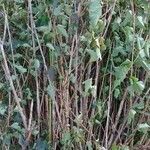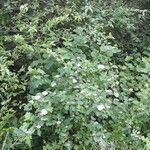Shrubs, to 30 dm. Stems spreading to ascending, ± glabrous. Leaves: stipules narrowly ovate, 6–10 × 1.5–2.5 mm, ?apex acute?; petiole 1–3 cm; blade ovate to obovate, 6–8.5(–10) × 4–7(–10) cm, usually longer than wide, base broadly cuneate to truncate, 3(–5)-lobed, margins irregularly serrate, apex obtuse to rounded, surfaces mostly glabrous, sometimes sparsely hairy abaxially. Inflorescences 30–50-flowered, open, hemispheric racemes, 5 cm diam.; bracts elliptic to spatulate or rhombic, 5 × 2.5 mm, apex acute to 3-fid or coarsely erose, ?faces glandular?. Pedicels 1–2 cm, usually stellate-hairy. Flowers 7–10 mm diam.; hypanthium cup-shaped, 1.5–2 mm, glabrous or sparsely stellate-hairy; sepals ?pale green to white, darker in center?, triangular, 1.5–2.5 mm, apex ?mucronate?, gland-tipped, surfaces usually stellate-hairy; petals white to pale pink, broadly elliptic to orbiculate, 4–5 × 4–5 mm; stamens equal to or exceeding petals, ?anthers purplish?; carpels 3–5, connate basally, sparsely stellate-hairy, glabrescent. Follicles 3–5, ?connate basally, bright red to brownish red?, ovoid, 5–10 mm (lengths ca. 2 times sepals), sparsely stellate-hairy, ± glabrescent; styles 4 mm. Seeds 2(–5), ?pyriform, 2 mm?. 2n = 18.
More
Shrub to 3 m, the bark exfoliating in narrow strips; petioles 1–3 cm; lvs ovate to obovate, the principal ones ± 3-lobed, irregularly serrate, broadly cuneate to truncate at base; pedicels 1–2 cm; sep 1.5–2.5 mm; fls 7–10 mm wide; fr 5–10 mm, glabrous or stellate-pubescent; 2n=18. Moist, sandy or rocky soil, especially along streambanks and shores; Que. to N.D. and Colo., s. to N.C., Tenn., and Ark., also escaped from cult. May–July. The form with stellate fr, commoner toward the west, has been called var. intermedius (Rydb.) B. L. Rob. (Opulaster opulifolius; O. australis)











